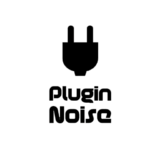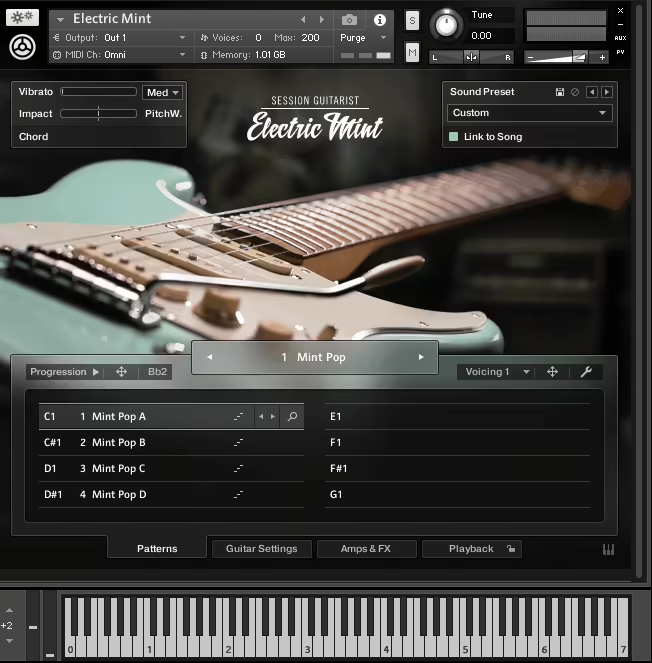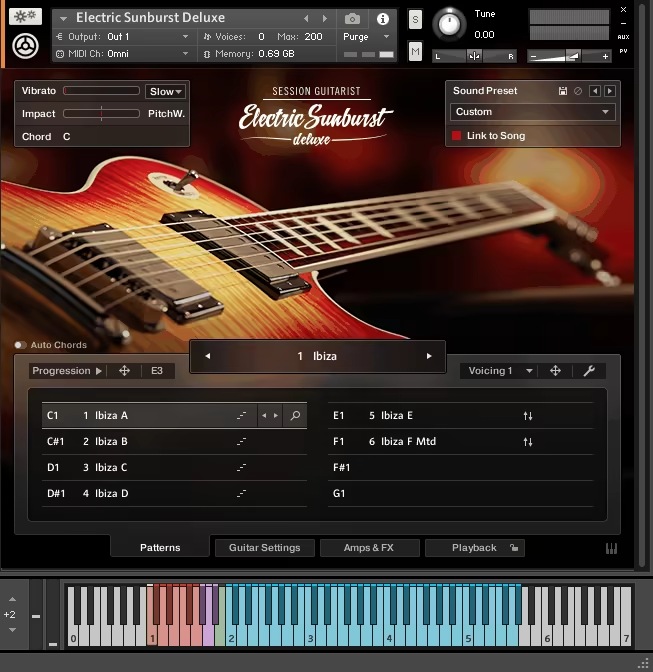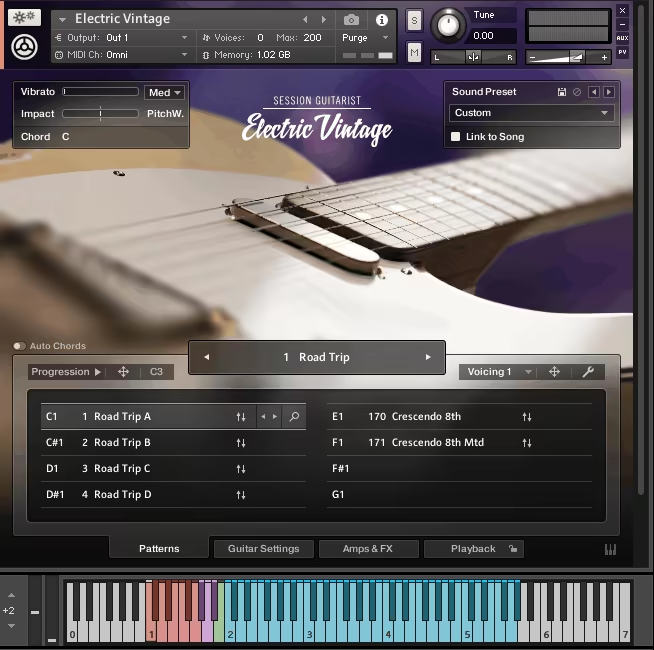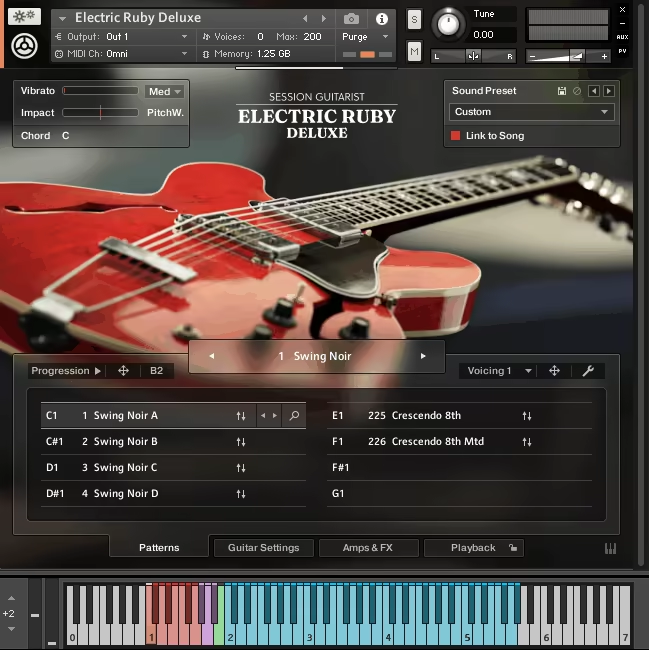Here we have the best electric guitar plugins and Kontakt libraries for 2025 with the most authentic tone, flexible workflows, and inspiring sound.
There’s something undeniably magical about the sound of an electric guitar, whether it’s a crunchy power chord, a soaring solo, or a clean riff bathed in chorus. But not everyone has the gear, skills, or space to record one properly. That’s where plugins and Kontakt libraries step in, giving you access to everything from vintage tones to modern metal, all without ever picking up a real six-string.
Over the years, electric guitar plugins have evolved from sounding stiff and synthetic to impressively lifelike, thanks to detailed sampling, expressive articulations, and advanced amp modeling.
Today, you can strum, shred, or fingerpick via MIDI and still achieve performances that feel alive and human. I’ve tried plenty of these tools, and it’s clear the line between “real” and “virtual” guitars has never been thinner.
Whether you’re producing rock, metal, pop, funk, or cinematic scores, there’s a plugin or library out there to match your style and bring that unmistakable electric guitar energy to your tracks. Let’s check out some of my top picks!
1. Ample Guitar SC (Stratocaster)
The first pick is Ample Guitar SC, as it nails that unmistakable Fender Strat sparkle successfully without feeling sterile or over-processed.
I’ve used plenty of Strat emulations before, but this one feels alive. The way it captures the subtle snap of the strings and the richness of each pickup position makes it stand out immediately. It’s the closest I’ve come to plugging a real Strat straight into my DAW.
The interface is clean and thoughtfully designed, which makes diving into articulations or strumming tools super easy. I enjoy how intuitive the Riffer engine feels; it’s not buried in menus, and editing MIDI feels natural rather than like a chore. Even with all the features packed in, the workflow stays smoot,h and I never feel lost or slowed down.
- Pickup Variety
The 4 pickup positions give me everything from warm neck tones to funky middle combos and biting bridge leads. I often layer the Neck + Middle setting when I want that classic Strat “quack,” and it always sits perfectly in a mix without extra EQing.
- Deep Riffer and Strummer Tools
I’ve had a blast using the Riffer engine to generate unique riffs, the rule-based randomization keeps things musical rather than chaotic. Pair that with the Strummer’s 28 play styles, and it’s ridiculously easy to sketch out convincing rhythm parts that sound human.
- Built-In Amps and FX Suite
The 6 amp models and full effects rack make it feel like a complete guitar rig. I liked throwing on the 6-tap echo and IR reverb when writing ambient parts, and it instantly transforms the guitar into a lush, cinematic texture.
If I had to nitpick, the sample library is pretty heavy at nearly 10 GB, so it does eat into hard drive space. But honestly, the realism and flexibility you get is worth the footprint.
For me, this plugin shines when I want authentic Strat tones without reaching for a real guitar, whether that’s clean funk, soaring blues solos, or layered indie textures.
Ample Guitar SC comes in VST2, VST3, AU, AAX, and standalone formats for macOS and Windows users.
2. NI Session Guitarist – Electric Mint
The first time I loaded up Electric Mint, I couldn’t help but grin, it’s basically a vintage Strat in Kontakt form, sampled with all the nuance and bite of a real ’60s classic.
What I love most is how it balances authenticity with usability: it’s not just a library of sounds, it’s a songwriting machine. I’ve used a lot of guitar VSTs over the years, but this one instantly stood out for how alive and musical it feels.
The interface is clean and exactly what I’d hope for in a Session Guitarist instrument. The workflow is straightforward: pick a style, audition patterns, tweak tone and pickups, then dive into amps and effects if you want more grit or space.
I really enjoy how quick it is to go from sketching a rhythm to laying down something that sounds like a real guitarist played it. Even the performance tab makes dialing in human feel a breeze, which saves me from robotic-sounding loops.
- Vintage Strat Sampling
All five pickup combinations from the original ’60s Fender Strat are here, and they sound gorgeous. I love switching between that glassy neck tone for funk patterns and the bridge pickup bite for rock riffs, it’s like having the guitar right in my lap.
- 222 Patterns & 53 Songs
This library isn’t just about playing single notes, it’s packed with strums, riffs, and progressions across genres. I’ve dropped in a few preset patterns for demos, and honestly, they sounded mix-ready without much tweaking.
- Amps & Effects
The built-in Supercharger GT compressor, Cry Wah, and convolution reverbs give me everything from clean DI sparkle to thick, overdriven crunch. I’ve saved entire effect chains inside the plugin, which makes it super flexible for switching projects fast.
- Performance Controls
Humanise, Swing, Feel, and Shift are a lifesaver for adding groove. I’ve nudged swing a bit for lo-fi beats and instantly got that lazy, pocketed vibe. The tremolo bar simulation is just icing on the cake for expressive leads.
- Chord Library & MIDI Drag-and-Drop
This might be my favorite part, I can drag patterns or chord voicings right into my DAW and rework them. I’ve even repurposed Electric Mint’s MIDI to drive synths for hybrid textures, which was a fun surprise.
Downsides? It’s not a full-on shred guitar library, so if you’re after blazing solos with endless articulations, you might want to layer it with something else. But for songwriting, band mockups, or even polished production, it nails that Strat soul perfectly.
I keep reaching for Electric Mint whenever I need instant guitar vibes without calling a session player. It’s inspiring, fast, and dripping with character, I’d call it one of the most usable guitar libraries NI has made so far.
Available in Kontakt and the free Kontakt Player for macOS and Windows.
3. Heavyocity Damage Guitars 2
Well, the best way to say it this: Damage Guitars 2, feels like summoning a metal guitarist straight into my DAW.
It basically goes beyond simple riff packs, cause it’s an entire arsenal of crushing rhythm guitars, searing leads, and cinematic textures that make me feel like I’m producing the next big rock trailer. I’ve used the first Damage Guitars a bunch, but this sequel just dials everything up to ridiculous levels.
The interface is classic Heavyocity: slick, intuitive, and built for fast workflow. I like how everything is tempo-sync’ed and laid out by tone and key, which makes auditioning riffs or leads quick and painless. The integration with Kontakt’s performance features also makes it easy to twist loops into something uniquely mine without breaking the vibe.
- 3 Tone Flavors
The ‘Metal’ and ‘Damaged’ tones bring brutal, modern aggression, while the ‘Hard Rock’ setting has that classic Marshall-style bite. I love swapping flavors mid-track just to see how the energy shifts, it’s like having three different guitarists in the room.
- 432 Riffs with Matching Bass
These riffs are the backbone of the library, and they absolutely slam. I’ve dropped them straight into mixes for instant weight, and the fact that matching basslines are included saves me a ton of time.
- 648 Leads & Licks
This is where the fun really starts. Bends, squeals, harmonics, shreddy runs, they’re all here. I’ve stitched together licks for solos that sound like I spent hours tracking with a guitarist, when in reality it took me five minutes.
- Articulations & Extras
From EBow sustains and divebombs to slides, trills, and feedback, it’s basically a toolkit of every cool guitar trick I’d want at my fingertips. The chugs and dead strokes are insanely tight, and I’ve been layering them under drums for extra punch.
- Designer Instrument
This is where Damage goes cinematic. I’ve built massive six-string soundscapes and rhythmic pulses that wouldn’t sound out of place in a Hans Zimmer score. My personal favorite is the ethereal “Six String Cloudscapes” pad; it’s like the calm before the storm.
Honestly, I don’t have many complaints, it’s not meant to cover every guitar style under the sun, so if you’re chasing jazz chords or clean funk, you’ll need another library. But for heavy rock, metal, and hybrid scoring, this is hands-down one of the most inspiring guitar tools I’ve touched.
I keep coming back to Damage Guitars 2 whenever I need instant aggression or cinematic punch, and pairing it with Rock Grooves 2 just locks everything into place rhythmically. It’s like having a full band in my DAW, minus the noise complaints and broken strings.
Available in Kontakt and Kontakt Player 7.10.5 or later for macOS and Windows.
4. Ample Guitar TC (Telecaster)
AmpleSound’s Telecaster recreation feels like plugging straight into a classic.
The first time I hit a note, I got that unmistakable “Tele twang”, sharp, snappy, and cutting through the mix like a knife. It’s unapologetically bright, the kind of tone that makes country riffs sparkle and funk grooves bounce.
The interface is classic Ample: no nonsense, easy to navigate, and packed with depth if you want to dig in. I often bounce between keyswitches and the tab player, and both feel fluid. It doesn’t bog me down with complexity but gives me options when I want to get picky.
- Authentic Telecaster Tone
This one’s all about the bridge pickup. No neck, no middle, just raw Tele bite. That focus makes it shine in places where you need edge. I’ve used it on indie tracks, blues jams, even some funk leads, and it always pops out of the speakers.
- Deep Performance Engine
Legato, slides, and the Guitar Pro import/export workflow are all here. Sometimes I’ll sketch ideas in Guitar Pro, drag them in, then export the MIDI right back out after tweaking, it’s a handy cycle that keeps things moving.
- A Versatile Strummer
This strum engine can get jangly, tight, or even heavy if you push it. My favorite trick is cutting back sustain for funk chops, then flipping it back to ringing chords for indie textures. If anything, I just wish it had a few more strum presets for quick background filler.
It doesn’t try to be every guitar, and that’s exactly the point. AGTC II nails one of the most iconic electric guitar voices in history, and every time I load it up, I know exactly what I’m going to get: Tele.
Available in VST, AU, AAX, and RTAS for macOS and Windows.
5. NI Session Guitarist – Electric Sunburst Deluxe
When I first loaded up Electric Sunburst, it instantly reminded me of why I loved Strummed Acoustic.
Only this time, NI handed me a virtual Les Paul with polished riffs and strums. It’s built for songwriters, producers, and anyone who needs a pro-sounding guitar part without spending hours tweaking MIDI.
The interface feels clean and inviting, very Kontakt, very intuitive. I didn’t have to fight with menus or hidden functions; the styles and chord options are right there, and the voicing and doubling switches make it feel surprisingly flexible. Within minutes, I had mix-ready guitar layers sitting perfectly in a track.
- Style-based Patterns with Riffs and Strums
Unlike the purely strummed approach of Strummed Acoustic, this one adds picking patterns and riffs, which I found hugely inspiring. I’ve dropped them into pop and rock sessions, and they always give the track instant groove without me having to overthink.
- Built-in Amp and Stompbox Modeling
The included amp and FX options aren’t overwhelming, but they’re exactly what I need. I love flipping from clean to crunchy tones without loading a separate plugin; it’s quick, musical, and convincing.
- Performance Controls
Humanization, swing, and chord voicing keep parts from feeling robotic. I often use the voicing option to add harmonic flavors to progressions, and the doubling switch instantly fattens things up when I want that layered guitar feel.
Sure, you can’t program your own patterns, and heavy power users might hit the ceiling faster than they’d like. But for me, that’s part of the charm, it’s designed to get you there fast, and it really does.
Whether you’re a composer on a deadline or just want to sneak some Les Paul vibes into a track, Electric Sunburst delivers without the headache.
Available for Kontakt and Kontakt Player on macOS and Windows.
6. Heavyocity Scoring Guitars 2
Scoring Guitars 2 is one of those libraries that oozes cinematic character the moment you open it.
Rather than chasing riffs or leads, it dives into softer, more atmospheric territory, mixing nylon and steel strings with touches of synth. I’ve leaned on it for emotional underscore work, especially when I need guitars to breathe and shimmer rather than cut through aggressively.
The Gravity engine makes exploring the library a joy. I’d often begin with a pad or pulse and then sculpt it further using the motion and effects controls. It’s wild how quickly a delicate acoustic layer can morph into something tense, evolving, and ready to sit under a dramatic scene.
- Complex Pads
These pads are where nylon, steel, and synth truly shine together. I love reaching for them when I need textures that feel both organic and modern, especially in hybrid scores.
- Rhythmic Pulses and Strums
The rhythmic side is just as strong. Between mapped strumming patterns and one-note pulses, it’s easy to sketch ideas that already sound polished and full of movement.
- Cinematic Guitar Scapes
This is where the sound design comes alive. Some presets lean eerie, others surreal, but they never lose that guitar identity, which makes them blend beautifully in a cinematic mix.
For me, Scoring Acoustic Guitars is less about shredding and more about storytelling. If atmosphere and emotion are what you’re after, this library is pure gold.
Available for Kontakt and Kontakt Player on macOS and Windows.
7. Ample Guitar LP (Les Paul)
Ample Guitar LP brings the legendary 1958 Gibson Les Paul Reissue straight into your DAW.
I love how it captures the warmth, sustain, and punch of a vintage Les Paul, making it perfect for soaring solos, crunchy riffs, or bluesy bends. The attention to detail in the samples and performance options means it feels like a real player is right there with you.
The interface is sleek and intuitive, letting me jump between pickups, tweak articulations, and dial in amps and effects without fuss.
The stars of the show are the Riffer and Strummer tools, which let me sketch ideas and then refine them with humanized timing and dynamic variations. Switching between amp models and mic positions is straightforward, making it easy to shape the tone to fit any mix.
- Polyphonic Legato & Articulations
I can slide chords, play legato runs, or add palm mutes, pinch harmonics, and slides, all with natural transitions and expressive realism. This feature really makes sequences feel like a live guitarist rather than a MIDI hack.
- Amp & Cabinet Simulation
With 5 amp models, 7 cabinets, and 8 mic types, I can blend DI, room, and cabinet signals to taste. From clean tones to rock grit, the system gives flexibility that rivals real-world amp setups.
- Riffer & Strummer Engines
The updated Riffer lets me draw, select, and edit MIDI notes quickly, while the Strummer auto-detects chords and offers hundreds of strum patterns. It’s perfect for both live-playing and sequencing authentic rhythm parts.
- Tab Player
Import Guitar Pro tabs or use the demo files to instantly generate realistic guitar performances. I’ve used it to turn written ideas into playable tracks without manually programming every nuance.
One downside is that Ample Guitar LP can be a bit CPU-intensive when stacking multiple effects and detailed articulations. Another limitation is that it only features 3 pickup positions, so some users might wish for more tonal options.
Overall, Ample Guitar LP is my go-to virtual Les Paul. It’s versatile, realistic, and inspiring, whether I’m laying down leads, chord beds, or cinematic textures. Its built-in amps, strummer patterns, and Riffer tools make it a complete guitar solution for any DAW session.
Available for macOS and Windows as VST2, VST3, AU, AAX, and standalone.
8. NI Session – Guitarist Electric Vintage
Session Guitarist Electric Vintage delivers the iconic twang of a ’50s Fender Telecaster, from bright, snappy country licks to soulful ballad picking, this library captures the charm and bite of a vintage Tele while keeping performance intuitive and accessible.
I really like how quickly it allows me to create polished guitar parts, whether I’m sketching ideas or finishing a mix.
The interface is well-organized, and designed to make crafting guitar parts painless. I particularly appreciate the dual-instrument approach: one for chord/picking patterns and another for melodic lines.
This makes layering performances or creating hybrid rhythm-and-lead parts extremely straightforward. Switching pickups, adjusting virtual amps, and blending effects is simple, letting me fine-tune the tone without fuss.
- Pattern Variety
From muted strums to arpeggios, riffs, glissandos, and harmonics, the included patterns cover ballads, country, Americana, funk, soul, pop, RnB, and rock. The reversed and dead-note patterns add an extra dimension, giving compositions more variety without complexity.
- Melody Instrument
The separate melody instrument expands playability with open, muted, flageolet, and tremolo-picked articulations. I found it very handy for creating melodic lines alongside pattern-based rhythm tracks within a single instance of the library.
- Customizable Tone
With neck and bridge pickup options, virtual amp simulations, and effect chains, I could dial in everything from sparkling cleans to punchy overdriven tones. Mixing the sound into my projects was quick and painless.
The only downsides I noticed are minor: the library is pattern-based, so users looking for fully free-form note-by-note playing might feel slightly limited, and the dual-instrument system can be a little confusing at first if you’re new to Session Guitarist. Otherwise, it’s very polished and intuitive.
Overall, Electric Vintage is a fantastic addition to the Session Guitarist series. It nails the Telecaster character, offers plenty of versatility for rhythm and lead parts, and makes creating realistic guitar performances effortless, a real time-saver for both guitarists and non-guitarists alike.
Available for macOS and Windows via Kontakt or the free Kontakt Player.
9. Ample Guitar RB (Rickenbacker)
Ample Guitar RB perfectly captures the chime and sparkle of a Rickenbacker 330-style electric guitar, bringing vintage ‘60s and ‘70s British pop and rock tones.
The plugin shines with its ability to easily offer you different rhythms, melodic hooks, or layered textures that feel lively and organic. It’s the kind of virtual guitar that invites experimentation while staying true to its iconic character.
The interface is clear, intuitive, and thoughtfully organized. I was able to switch between articulations, tweak the built-in amp sim, or sequence riffs in the Riffer engine without ever feeling overwhelmed. The Strummer module and Tab Player are especially handy for sketching out complete guitar parts in a few minutes.
- Authentic Vintage Tone
The sampled Rickenbacker 330 delivers a bright, punchy character with lots of definition, perfect for chiming rhythms and clean melodic lines. Even when layering multiple instances, the sound retains clarity and that classic jangle.
- Performance Articulations
With 11 articulations including slides, legato, palm mutes, harmonics, and mordents, plus polyphonic legato and slide smoothing, expressive phrasing is easy to achieve. I found it simple to create subtle nuances that make sequences feel played rather than programmed.
- Riffer & Strummer Engines
The Riffer allows for string rolls, random riff generation, and full MIDI control, while the Strummer module provides 28 playing styles and rhythm sequencing. I used these tools to quickly lay down realistic rhythm parts and intricate chordal textures.
- Integrated Amp & FX
Built-in amps cover Fender, Marshall, Mesa/Boogie, and Roland models, paired with 8 mic options and a comprehensive FX suite including EQ, compressor, echo, and IR reverb. Mixing in context was fast, and the 3D reverb visuals made fine-tuning spatial placement intuitive.
The main downsides are that the library is fairly demanding on CPU, especially when layering multiple instances with amp sims and FX, and some users might miss additional exotic patterns or pre-made riffs for quicker song-building.
Overall, Ample Guitar RB shines for anyone looking to capture that jangly British pop/rock vibe with flexibility and realism, whether for rhythm, lead, or layered guitar textures.
Available for macOS and Windows via VST2/3, AU, AAX, and Standalone.
10. NI Session Guitarist – Electric Storm Deluxe
If you want the sonic power of modern metal, Electric Storm Deluxe captures the chug, technical riffs, and ambient textures that define bands like Periphery, Karnivool, and Gojira.
From bone-crushing down-tuned riffs to subtle melodic lines, this Kontakt library makes heavy guitar performance accessible to producers who don’t want to wrestle with an 8-string in real life.
The interface is sleek and intuitive, with two Kontakt instruments included: a pattern-based Session Guitarist engine and a playable melody instrument with multiple articulations. I quickly appreciated how easy it was to swap patterns, trigger chords via keyswitches, and adjust dynamics using the Impact control, giving instant control over both rhythm and expression.
- Authentic Modern Metal Tone
Recorded on a high-end Framus 8-string guitar, the samples capture aggressive low-end punch alongside shimmering ambient layers. I found the DI options particularly useful for routing through my own amp simulations for extra tonal shaping.
- Extensive Performance Patterns
With 270 riffs, chords, and arpeggios organized into 63 song-based groups, the library covers a wide spectrum of modern metal playing. Switching between patterns or triggering single-note versions allows for highly dynamic arrangements that still feel organic.
- Melody Instrument & Articulations
The playable instrument complements the pattern engine, providing expressive techniques for solos, harmonics, and textural passages. I was able to layer melodic content over rhythm parts seamlessly, giving tracks a full, professional feel.
- Amp, Cab & FX Modelling
The integrated amp and cab suite delivers everything from tight, palm-muted chugs to soaring lead tones. Pairing these with external effects or the DI signal provides flexibility for mixing into dense arrangements without losing clarity.
The only downsides I noticed are a modest learning curve if you want to fully exploit the pattern engine, and the library can be CPU-intensive when layering multiple patterns with amp sims. Otherwise, Electric Storm Deluxe is a polished, versatile, and inspiring tool for modern metal composers and producers.
Overall, NI has successfully translated the complexity and intensity of contemporary metal guitar into an accessible virtual instrument. Whether you need heavy, low-tuned chugs, melodic leads, or ambient textures, Electric Storm Deluxe delivers both instant gratification and deep creative control.
Available for macOS and Windows via Kontakt and Kontakt Player.
11. NI Session Guitarist – Electric Ruby Deluxe
My last pick is Electric Ruby Deluxe, which brings the rich, resonant sound of a hollowbody electric guitar into your productions.
From jazzy comping to soulful leads, this library captures the woody warmth and single-coil sparkle that makes hollowbody guitars so iconic, all without needing to own the real instrument.
The interface is intuitive, with two Kontakt instruments included: a pattern-based engine loaded with hundreds of grooves, and a melody instrument for expressive, note-by-note performances. I found switching between pattern and melody modes seamless, letting me layer chord progressions with lead lines effortlessly.
- Authentic Hollowbody Tone
The samples convey depth, airiness, and punch, true to a classic hollowbody. I especially appreciated the nuanced single-coil timbre, which adds a lively, organic character that sits beautifully in mixes.
- Dual-Instrument Flexibility
Pattern mode lets you generate instant chord progressions with a wide variety of styles, while the melody instrument gives you total control over slides, harmonics, flageolet, and muted notes. I could quickly create a mix-ready rhythm part and then overlay a lead line that felt natural and expressive.
- Advanced Pattern Browser & MIDI Drag-and-Drop
Searching by rhythm, feel, articulation, or style is fast and intuitive. Drag-and-drop MIDI directly into my DAW meant I could tweak arrangements or revoice patterns on the fly without losing timing or groove.
- Amp & FX Integration
Electric Ruby Deluxe comes with a mid-60s-inspired amp (Reverb Delight) plus a range of Guitar Rig-powered pedals and effects. I found it easy to shape both classic warm tones and more modern, ambient textures without adding extra plug-ins.
The only downsides I noticed are that fully exploring the breadth of patterns and articulations takes a bit of time, and layering multiple instances with heavy FX chains can be CPU-intensive on older systems.
Overall, Electric Ruby Deluxe is a polished, versatile hollowbody instrument that excels for both rhythm and lead work. For jazz, blues, pop, or cinematic scoring, it’s a fantastic way to add expressive, high-quality electric guitar to your productions.
Available for Kontakt Player 8.5+ on macOS and Windows, with VST3, AU, and AAX plugin formats.
Conclusion
Wrapping up our deep dive into the best electric guitar plugins and Kontakt libraries for 2025, it’s clear that the virtual guitar landscape has never been richer or more versatile.
From the pristine, pattern-driven elegance of Native Instruments’ Session Guitarist series to the highly playable, amp-ready realism of Ample Sound’s guitars, today’s options let producers and composers achieve both classic and cutting-edge tones without ever touching a physical instrument.
What stands out across all these plugins is the balance of quality and usability. Engines like Gravity, Riffer, and NI’s dual-instrument design make complex performances accessible even to non-guitarists, while advanced FX, amp simulations, and articulation options give guitarists and sound designers the nuance needed for authentic, expressive results.
Many libraries now also include features such as pattern drag-and-drop, melody-focused instruments, and integrated amp/cab sims, bridging the gap between live performance feel and studio convenience.
Ultimately, whether you’re scoring cinematic moments, producing pop, or experimenting with metal and rock textures, these offerings provide a palette of tones and tools that inspire creativity, save time, and elevate productions. With virtual guitars this polished, the line between sampled and live performances keeps getting thinner!
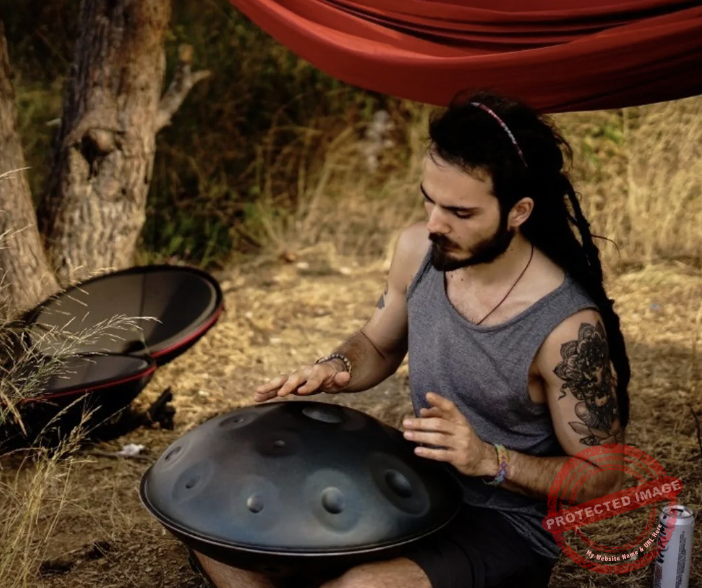
Berk Öztuna, a musician from Istanbul, is skilled in handpan, percussion, and guitar, performing and recording his own compositions globally. With expertise in music production and audio technology, he integrates virtual instruments and sound design tools seamlessly into his work. He also writes insightful articles on music production and gear for platforms like Plugin Noise and shares his music on Spotify and Instagram.
DONATE: Love our content? Help us keep Plugin Noise alive in the age of AI — Your donation fuels better content for music creators like you! You can donate here: pluginoise@gmail.com (Every amount counts.)
